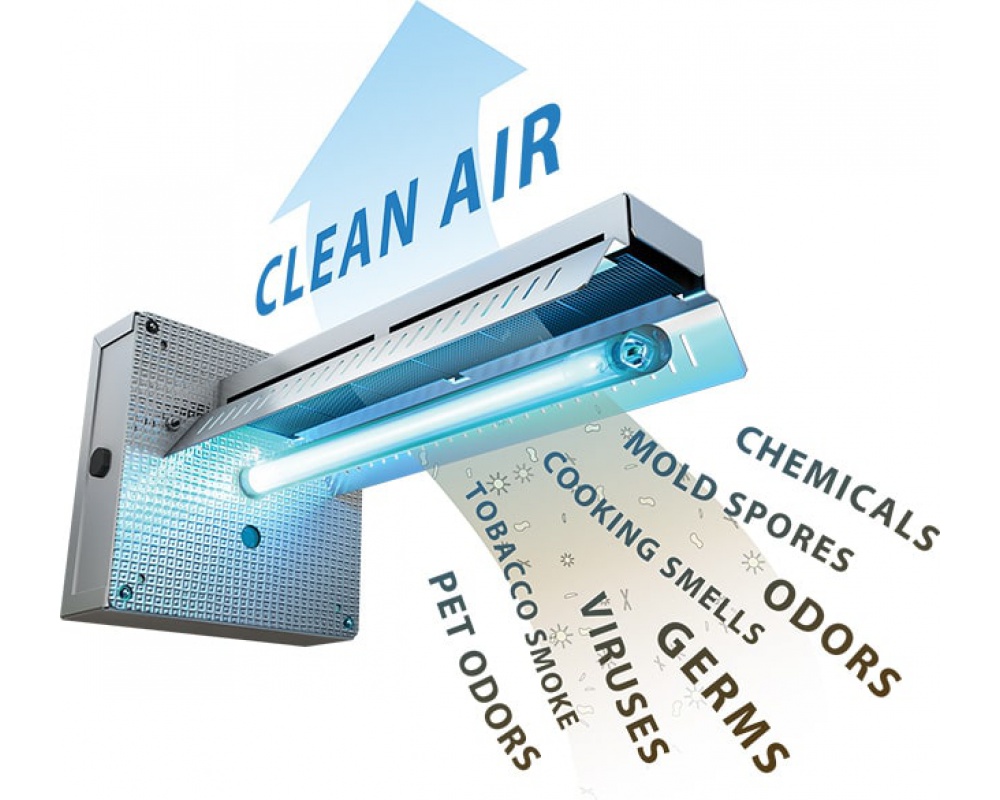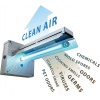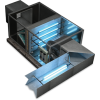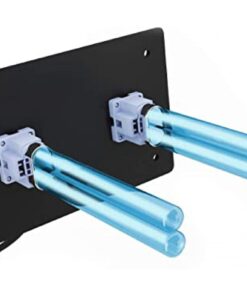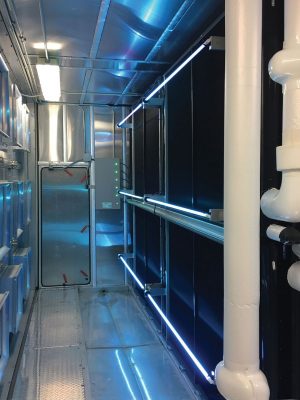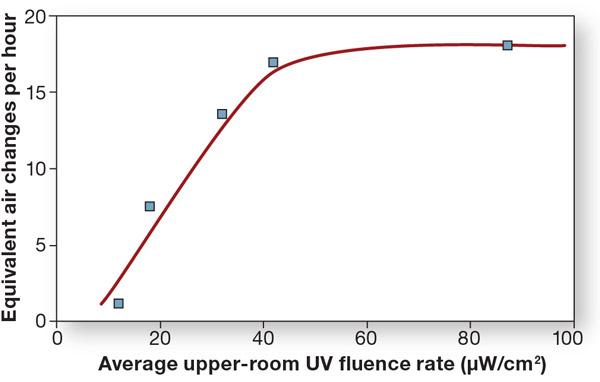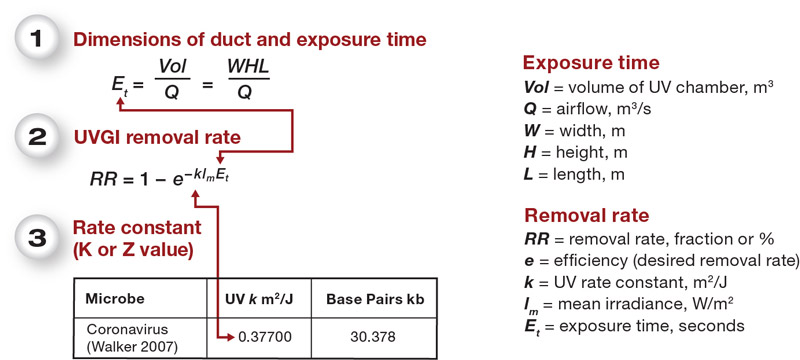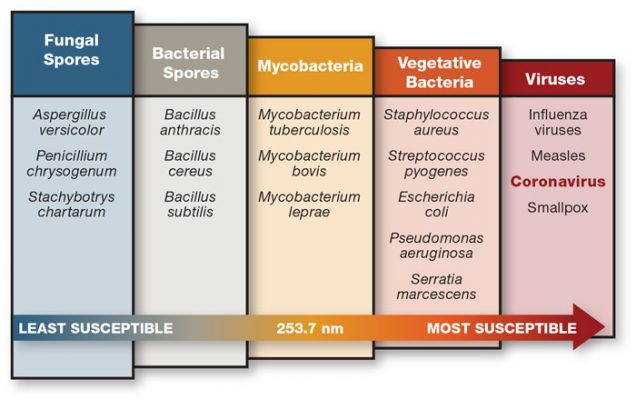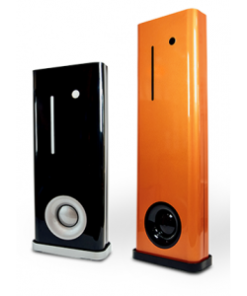UV-C installations within HVAC systems are predicted to be essential in the reality of the global pandemic – and rightly so. HVAC systems rapidly circulate the air, as well as any viruses within the air, throughout the environment in which they operate…filters, whether HEPA or otherwise, provide only limited protection. UV-C technology has been scientifically proven (further info here) to destroy and/or inactivate a plethora of airborne viruses, including COVID-19.
There are several advantages to installing UV-C disinfection devices into HVAC Systems;
- 100% Hidden from view – no large unsightly machines taking up valuable floor space
- UV-C irradiation is highly effective in inactivating SARS-CoV-2 replication
- As the UV-C lamps are in the direct path of the airflow of the system, there are no moving parts (portable devices require a fan in order to be effective)
- No moving parts = lower operating costs, and virtually zero maintenance. UV-C lamps typically last 6 to 12 months (5,000 to 9,000 hours) depending upon brand, usage, and the operating environment before requiring replacement
- UV-C lamps are engineered to neutralize and eliminate infectious airborne pathogens that cause respiratory illness and disease
- Disinfection of the cooling coil surfaces inhibits mold development which increases the efficiency of your systems and reduces the frequency of cooling coil deep cleaning requirements
- The most cost-efficient air purification method that meets Hong Kong Government Requirements to comply with the Prevention and Control of Disease Regulation Cap 599F.
Ultraviolet (UV) light is a proven technology that has been around for over 100 years. The first UV lights were used to treat tuberculosis. Since then they have been used extensively to kill mold, fungus, bacteria and viruses. UV light can be used to treat air, water and surfaces. UV germicidal lights have a clear quartz glass sleeve and produce a blueish light when turned on. The most commonly used UV light for HVAC & Air Purifying units are referred to as UV-C or Germicidal light. UV-C light has a very short wavelength of 253.7 nanometres. This short-wave ultraviolet light interrupts DNA base pairing which in turn causes the formation of pyrimidine dimers which lead to death of bacteria, viruses and protozoa.
These systems are installed in homes, medical facilities, research labs and businesses. It is imperative that UV-C lamps are replaced on a regular basis. Germicidal UV-C lamps have a useful average life of 5,000 to 9,000 hours. Useful life means that during this time the lamp is operating at an optimal output level for neutralizing mold, fungus, bacteria and viruses. Inherently, fluorescent technologies like UV germicidal lights depreciate in output over time. These lamps should be replaced before their EOL (End of Life), as the amount of UV radiation emitted decreases over time despite the lamp still providing light. The lamps may be giving off light, however after EOL has been reached the lamps will be emitting a decreased UV radiation.
For close to a century, short-wave ultraviolet (UV-C) energy has been used to destroy airborne and surface-bound microbes, including chickenpox, measles, mumps, tuberculosis, and cold viruses. Yet, despite decades of research and thousands of applications in hospital emergency and operating rooms, urgent-care centres, universities, and first-responder locations, UV-C has not been widely leveraged. The COVID-19 pandemic, however, has shone on a spotlight on UV-C’s effectiveness as an air and surface disinfectant.
Correctly installed, UV-C light will continuously reduce and even prevent the growth of dangerous microbes in HVAC systems as well as prevent the circulation of infectious pathogens in air streams.
Germicidal UV-C Basics
UV light is a band of electromagnetic radiation classified into four wavelength ranges: vacuum UV (100 to 200 nm), UV-C (200 to 280 nm), UV-B (280 to 315 nm), and UV-A (315 to 400 nm). Wavelengths from 100 nm to 280 nm are germicidal. At 253.7 nm (commonly referred to as “UV-C”), the UV wavelength changes the structure of DNA and RNA, the genetic code of all life forms, inhibiting the ability of cells to reproduce. While bacteria and viruses absorb UV-C energy at different rates, no microorganism tested to date has proven resistant when subjected to an appropriate dose.1
Various scientific studies have demonstrated that UV-C irradiation is highly effective in inactivating SARS-CoV-2 replication – see here for further information. Ongoing studies at Columbia University and elsewhere also indicate that, “UV is very efficient for killing this virus.”2,3,4
In May 2020, the Centers for Disease Control and Prevention (CDC) recommended to businesses preparing to reopen following the pandemic the use of germicidal UV to reduce the likelihood of disease transmission.5
UV lamps installed inside of an air-handling unit. Photograph courtesy of UV Resources
Killing/Inactivating Airborne Pathogens
During the 1940s, many hospitals began utilizing UV-C energy for the control of airborne infectious diseases. With the arrival and proliferation of antibiotics, use of germicidal UV began to wane. During the 1990s, drug-resistant “superbugs” and hospital-acquired infections renewed interest in UV-C, which can kill virtually any microorganism, including antibiotic-resistant germs.
The UV-C wavelength inactivates virtually all microorganisms living on HVAC surfaces, with kill ratios of up to 99 percent, depending on the intensity of the UV-C and the length of exposure.6
UV-C dose is determined by the amount of germicidal energy a pathogen absorbs over a specific period of time. In other words, UV-C dose is a function of time multiplied by intensity. Consider, for example, a surface-disinfection application involving cooling coils. The disinfection target (the coil surface) is stationary, so exposure, or “residence,” time is continuous. As a result, the intensity of the UV-C energy striking the surface can be relatively low. In the case of a moving air stream, however, exposure time is limited—a mere fraction of a second, in some cases—so UV-C intensity must be much greater.
It is important to note that microbe inactivation is a nonlinear function of UV-C exposure. In other words, “If a certain UV exposure kills 90 percent of a bacterial population (frequently referred to as ‘one-log kill’), doubling the exposure time or intensity can kill only 90 percent of the residual 10 percent, for an overall germicidal efficacy of 99 percent (‘two-log kill’).”7
In addition to reducing HVAC-surface and airborne bacteria, germicidal UV can be used to supplement and improve other infection-control strategies, such as room air exchange. When a required number of air changes per hour (ACH) cannot be achieved using outside-air ventilation alone, upper-room UV systems can perform germicidal “equivalent” ACH. “It has been estimated that when an average UV intensity of 10 µW/cm2 is present in the upper room, 63 percent of airborne tuberculosis germs that arrive there will be killed in 24 sec (the germicidal equivalent of one room air change), and, therefore, 99 percent will be killed in 2 min (equivalent of five air changes).”8 This is important, as pathogenic aerosols can be spread through HVAC systems.9 In fact, in July 2020, more than 200 scientists petitioned the World Health Organization to acknowledge that SARS-CoV-2 can be transmitted through air as an aerosol.10
ACH equivalents increase with germicidal intensity (Figure 1).
UV-C can supplement protocols for disinfection, sterilization, and manual cleaning, providing a level of protection in the event a protocol fails. Facility managers are encouraged to implement a layered approach incorporating multiple infection-control measures to ensure that any pathogen that cannot be removed by one method (e.g., filtration, cleaning) is inactivated by another (UV-C).1
Applying UV-C Energy
FIGURE 1. UV-C-induced inactivation of Mycobacterium parafortuitum in a test room under well-mixed conditions at 50-percent relative humidity.11
There are three primary means of applying UV-C energy to protect HVAC surfaces and air streams against infectious agents: upper-room/air systems, HVAC air-stream disinfection, and HVAC coil/surface irradiation (Table 1).
Upper-room/air systems. One of the oldest applications of germicidal UV for space infection control, upper-room/air systems work by effectively intercepting pathogens and viruses at their source in room air. These fixtures are efficient against droplet nuclei from coughing, sneezing, or talking, as well as pathogens circulated by drafts, pressure differentials, or the movement of people.
Airborne droplets containing infectious agents can remain in room air for 6 min or longer. Operating 24/7/365, upper-room/air germicidal fixtures can inactivate these microbes in a matter of seconds.
Upper-room/air UV-C fixtures utilize the natural rise and fall of convection or mechanical air currents to circulate airborne infectious agents into the upper room, where they are exposed to UV-C radiation and killed. Studies have shown that one hour of use of an upper-room/air UV-C fixture can be equivalent to 10 to 16 air changes.11
Wall-mounted at a height above 7 ft, these fixtures use non-reflective baffles to direct UV-C energy upward and outward, ensuring that stray emissions do not enter the occupied portion of the room. First-pass kill or inactivation ratios of up to 99 percent have been modeled, with concentrations further reduced with each subsequent pass of recirculated air (“multiple dosing”). The goal, relative to coverage, is to maintain a UV-C irradiance level of at least 50 µW/cm2 in the upper room.
TABLE 1. Germicidal-UV application.
While upper-room/air UV-C “is very effective in areas with no, or minimal, ventilation,”12 in spaces with no or weak air circulation, ceiling fans can compensate for the lack of sufficient mechanical air movement and improve inactivation rates (see sidebar, “Improving Upper-Room UV With Ceiling Fans,” below).
HVAC air-stream disinfection. In HVAC air-stream disinfection, UV-C fixtures installed in air-handling-unit (AHU) plenums, air-distribution systems, or HVAC ductwork inactivate microorganisms “on the fly.” Simplified, the germicidal dose is determined by the UV-C intensity, exposure time, and target pathogen’s susceptibility to UV-C.
In addition to the amount of germicidal energy absorbed by a pathogen over a specific amount of time, a variety of other factors are taken into consideration when UV-C is applied for HVAC air-stream disinfection. These site-specific considerations will be explored in the next section.
HVAC coil/surface irradiation. The most common type of germicidal-UV system, HVAC coil/surface irradiation continuously targets bacteria, viruses, mold, and biofilm that proliferate on coils, air filters, duct walls, and drain pans, preventing them from becoming reservoirs for pathogen growth.
A coil/surface-irradiation system can eliminate up to 30 percent of airborne pathogens on a first-pass basis, with concentrations reduced further with each subsequent pass.
For coils, The American Society of Heating, Refrigerating and Air-Conditioning Engineers (ASHRAE) recommends irradiance levels of 50 µW/cm2 to 100 µW/cm2.12 Perhaps a better way to achieve a desired dosage is to convert 100 µW/cm2 to the more easily understood and specifiable 7.5 lamp watts (as printed on the lamp surface) per square foot of coil surface area.13 By making this conversion, frontline engineers easily can verify that submittals conform to their specifications.
TABLE 2. Reflectivity of different metals.
Environmental Factors
There are many operational and site-specific conditions that impact inactivation or kill rate, including:
- The target pathogen and its susceptibility to UV-C. The amounts of UV-C energy needed to inactivate individual bacteria, viruses, and spores have been identified through decades of research.14
- The volume and velocity of air traveling through the HVAC system, which will impact the length of residence time. A higher volume of air and/or faster-moving air requires greater intensity (more UV-C lamps) and/or a longer run of duct to increase residence time. Said differently, as velocity increases beyond the typical 500 fpm, UV intensity must increase with it. Conversely, less UV intensity is required for air velocities below 500 fpm.
- The length of the plenum/duct—the longer the plenum or duct run, the better, as residence time and, thus, dose are increased.
- Fixture spacing—decreasing lamp-row spacing (e.g., from the surface-irradiation standard 36-in. centerlines to 15-in. to 18-in. centerlines) increases UV-C fluence.
- Temperature—because cold air reduces the output of UV-C lamps and high relative humidity affects pathogen susceptibility to UV-C, air-stream-disinfection measures can be more effective on the upstream side of a coil. Although on-the-fly disinfection can be accomplished downstream of coils, it typically requires an increase in UV-C intensity (more lamps).
- The lamps—using more or higher-output lamps will increase the total dose—that is, the microwatt-seconds per square centimeter (µW-s/cm²). Lamps with 360-degree irradiation allow more UV-C energy to saturate a plenum, increasing UV-C fluence. Some UV-C lamps are encapsulated with an anti-shatter fluorinated-ethylene-propylene (FEP) coating or outer sleeve that helps to insulate the lamp surface from changes in temperature and/or air volume. This protection can be beneficial when the temperature is low and/or the air-stream velocity is high, but it also can reduce UV output by up to 10 to 12 percent.
- The reflectivity of the plenum—reflective metals boost UV-C dose, as the germicidal wavelength “bounces” throughout the plenum and remains “in play” instead of being absorbed by the surfaces. Different metals have different reflectance multipliers that can significantly increase UV-C fluence levels (Table 2).
FIGURE 2. Air-stream disinfection.15
FIGURE 3. Microorganisms susceptible to germicidal UV-C.12
FIGURE 4. Options for UV-fixture placement in an air handler. Left: downstream of a coil for coil/surface cleaning, with fixtures spaced on 36- to 40-in. centerlines. Middle: upstream of a coil for air-stream disinfection (treatment also can be installed downstream). Right: dual application, with more tightly spaced UV-C lamps upstream of a coil for air-stream disinfection and less UV-C intensity downstream of the coil for coil/surface cleaning.
Pathogen Susceptibility
Although environmental factors influence UV-C dosing, it is best to consider all aspects of an application in a predictive-modeling formula when designing an air- or surface-disinfection strategy.
In Figure 2, we can calculate the amount of time a pathogen is exposed to UV energy to determine the total exposure time.
Bacteria and viruses vary in susceptibility to UV energy, with environmental organisms, fungal spores, and mycobacteria being relatively harder to kill than more rapidly replicating and non-environmental microbes and most bacteria. But even fungi are killed effectively with high-dose UV.7 For example, studies have demonstrated that viruses are more susceptible to UV-C inactivation than typical bacteria are (Figure 3).15
Lamp Placement
When designing a germicidal-UV disinfection system, engineers should consider the impact AHU location has on performance. Because cold air affects the output of UV-C lamps and high relative humidity affects pathogen susceptibility to UV-C, air-stream disinfection can be more effective when lamps are installed upstream of a coil. In fact, moving UV-C lamps from the typical downstream temperature of 55°F to the typical upstream temperature of 70°F can increase lamp output by up to 40 percent (figures 4 and 5).
Cooler temperatures downstream of a coil can be overcome with the use of FEP-coated lamps and/or more lamps.
FIGURE 5. UV-C fixtures installed both upstream and downstream of a cooling coil provide both air-stream disinfection and coil cleaning.
CONCLUSION
Facility professionals can utilize germicidal-UV technologies to greatly reduce concentrations of pathogens in a highly reliable and cost-effective fashion.
The UV-C wavelength can kill 99 percent or more of all microorganisms living on HVAC air ducts and evaporator coils, depending on UV-C intensity, length of exposure, UV-lamp placement, and lamp life cycle.12 Operating 24/7/365, upper-room/air germicidal fixtures can inactivate microbes in under a second.
Germicidal UV has been extensively researched and is recognized in two ASHRAE Handbook volumes, HVAC Applications12 and Fundamentals16; two ASHRAE test standards, ANSI/ASHRAE Standard 185.1, Method of Testing UVC Lights for Use in Air Handling Units or Air Ducts to Inactivate Airborne Microorganisms, and ANSI/ASHRAE Standard 185.2, Method of Testing Ultraviolet Lamps for Use in HVAC&R Units or Air Ducts to Inactivate Microorganisms on Irradiated Surfaces; and three ASHRAE position documents, Filtration and Air Cleaning,6 Airborne Infectious Diseases,17 and Infectious Aerosols.18
What’s more, germicidal UV has been recognized in CDC guidance for office buildings,5 health-care facilities,19,20 and dental settings.21
References
- IUVA. (n.d.). IUVA fact sheet on UV disinfection for COVID-19. International Ultraviolet Association. Retrieved from http://www.iuva.org/COVID-19
- Buonanno, M., Welch, D., Shuryak, I., & Brenner, D.J. (2020). Far-UVC light efficiently and safely inactivates airborne human coronaviruses. Scientific Reports, 10. Retrieved from https://bit.ly/Buonanno_Far-UVC
- Bianco, A., et al. (2020). UV-C irradiation is highly effective in inactivating and inhibiting SARS-CoV-2 replication. Retrieved from https://bit.ly/Bianco_UV-C
- Inagaki, H., Saito, A., Sugiyama, H., Okabayashi, T., & Fujimoto, S. (2020). Rapid inactivation of SARS-CoV-2 with deep-UV LED irradiation. Emerging Microbes & Infections, 9. Retrieved from https://bit.ly/Inagaki_Rapid
- CDC. (2020). COVID-19 employer information for office buildings. Centers for Disease Control and Prevention. Retrieved from https://bit.ly/CDC_Reopen
- ASHRAE. (2015). ASHRAE position document on filtration and air cleaning. Retrieved from https://bit.ly/ASHRAE_Position
- IES. (2020). IES committee report: Germicidal ultraviolet (GUV) – Frequently asked questions. Illuminating Engineering Society. Retrieved from https://bit.ly/IES_GUV
- First, M.W., Nardell, E.A., Chaisson, W., & Riley, R. (1999). Guidelines for the application of upper-room ultraviolet germicidal irradiation for preventing transmission of airborne contagion—Part I: Basic principles. ASHRAE Transactions, 105. Retrieved from https://bit.ly/First_Upper
- Jayaweera, M., Perera, H., Gunawardana, B., & Manatunge, J. (2020). Transmission of COVID-19 virus by droplets and aerosols: A critical review on the unresolved dichotomy. Environmental Research, 188. Retrieved from https://bit.ly/Jayaweera_COVID-19
- Morawska, L., & Cao, J. (2020). Airborne transmission of SARS-CoV-2: The world should face the reality. Environment International, 139. Retrieved from https://bit.ly/Morawska_Airborne
- Miller, S.L., Hernandez, M., Fennelly, K., Martyny, J., & Macher, J. (2002). Efficacy of ultraviolet irradiation in controlling the spread of tuberculosis. Retrieved from https://bit.ly/Miller_Efficacy
- ASHRAE. (2019). ASHRAE handbook—HVAC applications. Atlanta: ASHRAE.
- Fencl, F. (2013, October 7). Rightsizing UV-C lamps for HVAC applications. HPAC Engineering. Retrieved from https://bit.ly/Fencl_Rightsizing
- Kowalski, W.J., Bahnfleth, W.P., & Hernandez, M.T. (2009, June). A genomic model for predicting the ultraviolet susceptibility of viruses. IUVA News. Retrieved from https://bit.ly/Kowalski_Genomic
- Kowalski, W. (2009). Ultraviolet germicidal irradiation handbook: UVGI for air and surface disinfection. Springer-Verlag Berlin Heidelberg.
- ASHRAE. (2017). ASHRAE handbook—Fundamentals. Atlanta: ASHRAE.
- ASHRAE. (2014). ASHRAE position document on airborne infectious diseases. Retrieved from https://bit.ly/ASHRAE_Airborne
- ASHRAE. (2020). ASHRAE position document on infectious aerosols. Retrieved from https://bit.ly/ASHRAE_Aerosols
- Sehulster, L., & Chinn, R.Y.W. (2003). Guidelines for environmental infection control in health-care facilities. Centers for Disease Control and Prevention and Healthcare Infection Control Practices Advisory Committee. Retrieved from https://bit.ly/CDC_HICPAC
- DHHS. (2009). Environmental control for tuberculosis: Basic upper-room ultraviolet germicidal irradiation guidelines for healthcare settings. Department of Health and Human Services. Retrieved from https://bit.ly/DHHS_tuberculosis
- CDC. (2020). Guidance for dental settings. Centers for Disease Control and Prevention. Retrieved from https://bit.ly/CDC_Dental


